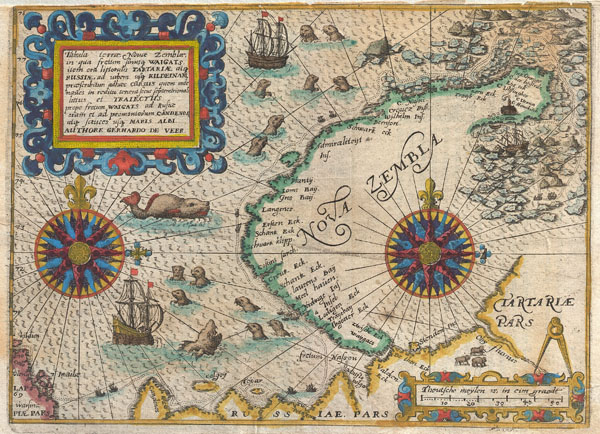This item has been sold, but you can get on the Waitlist to be notified if another example becomes available, or purchase a digital scan.
1601 De Bry and de Veer Map of Nova Zembla and the Northeast Passage
NovaZembla-debry-1601
Title
1601 (undated) 7 x 9.5 in (17.78 x 24.13 cm)
Description
Drawn by Gerhardo de Veer, a survivor of all three of Barentsz's expeditons, and published c. 1601 by Theodore de Bry in the third issue of the first Latin edition of Grands et Petits Voyages.
CartographerS
Gerhardo de Veer (c. 1560 - 1620) was a Dutch sailor who accompanied the Friesian explorer William Barantsz on three ill fated expeditions into the Russian Arctic in search of a Northeast Passage. Unlike Barantsz himself, de Veer survived all three voyages as well as a harrowing winter on the glacier bound northern tip of Nova Zembla. After the death of Barentsz, de Veer and several other sailors made their way south through treacherous ice flows to the relative safety of the Russian port of Kola. It is largely through Gerhardo de Veer's narrative and maps that we know of the tragic events of Barentsz's third voyage. More by this mapmaker...
Théodore de Bry (1528 - March 27, 1598) was an important publisher active in the mid to late 16th century. De Bry was born in 1528 in Liege, then a Prince-Bishopric and thus independent of neighboring nations. The De Bry family were accomplished jewelers and copperplate engravers and, following the family tradition, Theodore apprenticed in these fields under his grandfather Thiry de Bry senior (? - 1528), and later under his father, Thiry de Bry junior (1495 - 1590). To avoid growing religious strife in the region Théodore de Bry left Liege for the more tolerant Strasburg. Shortly afterwards, in 1577, he moved again to Antwerp and, in 1580 to London, where he became well known for his engraving skills. It was either in Antwerp or in London that De Bry befriended the English publisher and editor of traveler's tales Richard Hakluyt. Inspired by Hakluyt's work, De Bry began to collect travelers' tales, particularly of voyages to New World. His most prominent acquisition was most likely the letters and papers of the French painter and mapmaker Jacques Le Moyne de Morgues discussing a disastrous attempt by French Huguenots to colonize parts of Florida. Around, 1588 De Bry moved to Frankfurt where he began his own publishing firm. Among De Bry's earliest and most prominent publications are his Grands Voyages, a multivolume compilation of travelers' tales that included the work of Le Moyne as well as some of the earliest published depictions of the North American mainland. The firm also published various other works including an important account of early English attempts to colonize Virginia with illustrations by John White. De Bry died in Frankfurt on March 27, 1598, having never left the shores of Europe, though his name was associated throughout Europe with tales of travel and adventure. Théodore de Bry was succeeded by his son Jean-Théodore (1560 - 1623) who continued the publishing firm until his own death in 1623. Learn More...

